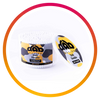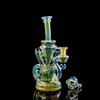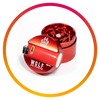The Struggle to Determine What Truly Constitutes Heady Glass
You don’t have to be well acquainted with the smoke shop scene to have heard the term “heady” bandied around. The concept has been floating about since at least the 1500s, though its association to stoner culture is much more closely associated to the 1970s when neighborhood head shops were beacons for those “in the know” as well as curious passersby. Amplified by Jefferson Airplane’s psychedelic anthem “White Rabbit” in which singer Grace Slick passionately invites the open-minded listener to “feed your head”, the concept became intrinsically linked to spiritual and philosophical sojourns aided by mind-altering substances. But the 1970s were a long time ago and the term has evolved considerably and often bafflingly. At Dab Nation, we professionally concern ourselves with heady glass specifically. But what makes a glass dab rig “heady”? You might as well start with an easier question, like “What is art?” But to get as close to an answer as possible, we sat down with Dab Nation’s resident heady glass experts, Retail Manager Wayne and Product Specialist Camille, to see if they could get us closer to the source.
The Origins of Heady Glass
Returning to the headshops of the 1970s, it was common for glass artists to create a “head piece”; an example of glass art (often a water pipe or similar smoking paraphernalia) so impressive that the shop owner couldn’t bear to part with it. This piece would typically be placed on prominent display for shoppers to admire as it set the tone of the headshop experience. “But back then, it could also reference the headstash,” explains Wayne. “You’d have the stash you shared with friends, but then also your personal stash that you reserved for more introspective moments. This was called your ‘headstash.’ A heady glass piece often featured a smaller bowl because you’d be packing less at a time. It wasn’t a piece you’d be passing around with your friends but rather one you’d reserve for when you wanted to smoke alone. So, heady glass pieces often have a thought-provoking quality to them.” But what inspires one person may not inspire the next, so is there any way to define heady glass with any real certainty?
Factors That Can Define Heady Glass
Camille, who has logged thousands of hours helping novices and aficionados alike find the perfect heady glass additions to their collections, helped us to understand some of the factors that may qualify a glass dab rig as “heady.” “Artist recognition is usually part of it,” she mentions immediately. Just as in other facets of the art world, a name can dramatically elevate the desirability of a piece. The Dab Nation crew are often visited by glass connoisseurs specifically searching for any heady glass for sale crafted by a specific artist they follow closely. But reputation isn’t the only factor to consider when assessing the headiness of a piece. Any noteworthy functionality can raise a glass dab rig to heady status, whether this be some sort of novelty or complexity. You can take myriad other factors into account, such as remarkable craftsmanship, the rarity of a piece or even the scarcity of materials used in its creation.
Further Flavoring a Heady Piece with Decorative Techniques
Then there’s the matter of technique. While technique alone isn’t likely to define a heady glass piece (unless it’s executed in a novel or grandiose way), a variety of glass decorative techniques are often incorporated to elevate the nuances and details of a piece that contribute to its overall headiness. You’ll often find fiery bands of jagged wig wag designs bisecting tubes, gilded fuming in which metal is actually infused into the glass to create a warm radiance, or complex patterns facilitated through painstaking dot stacking techniques. While several glass decoration methods have their roots dating back to ancient practices of glassworking, artists are finding ways to put their personal touch on these storied techniques and using them to embellish their heady glass works.
A Tour with a Resident Connoisseur
Since Camille’s reputation as a heady enthusiast is well-known around the Dab Nation LA location, we asked her to point out some of her favorite heady glass pieces in the shop. After some thought, she introduces us to the bulbous menace of the Hendy Glass Invader Dab Rig, a curvaceously cartoonish extra-terrestrial in a sky blue retrofuturistic jumpsuit, peering forth from a glass display case with a face reminiscent of a skull. Next to it is another Hendy piece; a heady glass take on the Hindu deity Ganesha blissfully meditating beneath a technicolor turban bejeweled with a third eye crafted from genuine opal. Her next choice sheds the whimsy of the Hendy pieces for a more obvious sense of grace in the ethereal radiance of a Fumed Trout Recycler Rig from Habitat Glass. Here we find the complexity she had mentioned earlier with serpentine twists of heavily fumed glass tubing almost seeming to insinuate the fluid sway of a fish navigating an aqueous dreamscape. But her favorite is a piece that she purchased from Dab Nation to add to her personal collection: a lavender Balloon Dog Mini Rig from Blitzkriega which stands guard nestled amongst office supplies on her desk. She proudly fires up a dab torch and gives us a demonstration of the heady glass rig in action, explaining the intricacy and ingenuity with which the piece must have been crafted.
Defying Definition
Just as we’re starting to understand the link between these seemingly disparate heady pieces, we ask if one can always identify a heady glass piece simply by looking at it. “Not everyone can,” Wayne admits as Camille shakes her head. “I mean, people ‘in the know’ can and that’s part of the heady experience. There can be some elitism to it. But if you think you can always tell heady glass just by looking at it, you should look up T.K. Happa.” Within seconds, Wayne pulls up the renowned Japanese glass artist’s Instagram page and holds it up as if to illustrate his point. The artist has nearly 40,000 followers and not a single post. Camille reminds us of the power of artist recognition in defining heady glass while Wayne pulls up examples of Happa’s work in a Google image search. The pieces are graceful in their minimalism, but lack the dynamic complexity and carnivalesque color of the heady glass pieces we’d seen thus far. But with Happa’s elegantly simple pieces regularly fetching thousands of dollars, we’re seemingly back to square one in our understanding of what makes a glass piece particularly heady. This is only confounded further when contrasted against the almost impossibly ornate, painstakingly detailed Banjo Glass Devi Goddess pieces Wayne pulls up in another image search: the intricacy and nuance of exalted myth cast in vibrant explosions of multi-colored glass. A Banjo Glass Devi Goddess is as opposite as you can get from a T.K. Happa piece. So how are these both considered sterling examples of heady glass?
The Heart of Heady Glass
“How many times have you been looking at paintings at a museum and seen a blank canvas with one painted square in the lower corner or maybe one where it seems the artist just splattered paint haphazardly across the canvas?” Wayne asks. “Some people look at that and think, ‘I could do that.’ But does that mean it’s not art?” We follow Wayne’s point, but still struggle to find a way of understanding it concretely. “I think it’s just whether a piece really speaks to you,” Camille chimes in, still holding her prized Blitzkriega Balloon Dog. “It’s glass art that allows you to feel a personal connection.” And perhaps that’s what truly is at the heart of headiness. In that way, could a simple candy cane dabber be considered heady glass to some isolated individual in a small town just sparking their interest in the expansive world of glass art? Who are we to really say? Perhaps the only person who can truly determine the parameters of heady glass is the individual.
If you’re tired of being a spectator and would rather be a patron of the glass arts, the Dab Nation crew has the knowledge, experience and passion to help you on your way. Whether there’s a particular artist you’re curious about, a vibe you’re seeking, or you don’t have the first clue where to start, a Dab Nation team member is always happy to talk glass with you to help you add the perfect piece to your collection. Give us a call at our Los Angeles location (323-717-8015) or our Denver location (720-812-0160) or send us an email at citizens@dabnation.com and let’s talk glass! And if you sign up to our Citizen’s List, you can get the heads up on new drops from heady artists, call dibs on rare and in-demand pieces, and get in-depth knowledge on our deep and ever-revolving catalog of collectible glass! These are just a few of the perks of being a Dab Nation citizen!


























Comments
Leave a comment